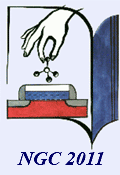
Nano and Giga Challenges
in Electronics, Photonics and Renewable Energy
Symposium and Summer School (Tutorial Lectures)
Moscow - Zelenograd, Russia, September 12-16, 2011


|
Nano and Giga Challenges in Electronics, Photonics and Renewable Energy Symposium and Summer School (Tutorial Lectures) Moscow - Zelenograd, Russia, September 12-16, 2011 |  |
Commentary Dario Narducci
It is actually difficult (and possibly senseless) to set a birth date for chemical sensing. Although the very first devices, based on the electrochemical detection of ions in Nernst cells, date back to the end of the XIX century, modern chemical sensing may be set to date from the invention of amperometric glucose sensors in 1982. Since then, in spite of the huge amount of research devoted to improving and extending the range of (bio)chemicals detectable, some of the paradigms in biosensing have not changed - at least up to very recent years. Detection is always based on a measurement chain, the selectivity relying on the suitable choice of a molecule (often natural: enzymes, proteins, microbes, antibodies or antigenes) that in turn triggers a physico-chemical response, ranging from the release of a molecule to the redox of a chemical shuttle. By the end of the chain, a physical quantity is measured (e.g. a voltage, a current, the change of some spectroscopic property). Along this avenue a relevant number of medical essays have been released, nowadays of current use by practitioners and, sometimes, untrained end-users. The success of this strategy relies upon three factors: (1) selectivity and sensitivity, two paramount parameters qualifying the effectiveness and the reliability of a bed-side test, are guaranteed by the close and often exclusive pairing between the analyte and the sensing molecule; (2) the physical part of the sensing device (the actual detector) operates as an almost neutral platform that can be modified only in its chemical section using standard functionalization methods, so as to make the use of miniaturized electronics economically sustainable; and (3) the large acceptance and uniformity of the market biosensors are aimed at, that gave the overall enterprise the proper spin to reach technological maturity. As a counterproof, gas sensing is still lagging in its childhood, since none of these points have been (yet) systematically verified - and it comes therefore to no surprise that some of the effort in the field are attempting to recovery the biosensing paradigma. Although intrinsically successful as they are, biosensors were recently shown to outmatch their potentials whenever used in combination with each other (and with other sensors) in architectures known as sensor arrays. Properly supplied with the artificial intelligence coming from numerical machines such as artificial neural networks, sensor arrays add to the possibility of detecting a single analyte that of recognizing complex scenarios, such as pathologies in humans, supporting at a higher level medical diagnosis. In turn, this new range of possible uses of biosensors is triggering the request for a new class of biosensors with extreme capabilities of detection at the single-molecule level. The experimental use of carbon nanotubes and of metal or semiconducting nanowires well instantiates this recent trend, and will surely deserve exciting new opportunities both to the communities of sensor specialist and of professional users (in medicine, pharmaceutical science and veterinary medicine, to name just a few of them). If we wish to glance ahead, it is not unrealistic to foresee that the next frontier will be of distributing sensor arrays. Especially in diagnostics, collecting information in several, selected regions of a living organism (instead than in one only, as done today) enables opportunities not just to detect pathological situations at a systemic level but also to localize it. Think, as an example, to cancerous cells - but also to partial occlusions of blood vessels, localized infections and so on. Miniaturization of simple (dedicated) sensors to be inoculated into the circulatory system is already at reach, and the possibility of deploying miniaturized fleets of communicating nanosensors aiming at different analytes is one of the possible strategies to recover the sensor array concept at the sub-micron scale without invoking extreme downscaling. For strange this may sound, although scientific and technological issues (e.g. intercommunication among sensors and with the macroworld, motility at the nanoscale) are not minor, the toughest hurdle to overcome is economical in nature. The initial investment required for R&D and manufacturing is clearly comparable to that of the microelectronic industry, namely orders of magnitude larger than that involved in state-of-the-art bedside sensing devices. Although also the prospective market is comparable if not larger than the current microelectronic market, the inertia to be overcome in order to trigger the virtuous loop of investments and revenues is notably critical. Nonetheless, it is probably not exceedingly optimistic to believe that, along with the growth of life expectation and the consequent aging of the first- and second-world population, the need to enhance the health prevention policies might lead to a situation where the balance between medical costs and manufacturing investments might revert, making technological ideas of this type sustainable and cogent.
Selected bibliography
1. D. Narducci, G. Girardi, C.M. Mari, and S. Pizzini, Application of Surface Science to Preparation and Characterization of Solid State Chemical Sensors, Sensors & Materials, 8 (1996) 223-229 (Japan). |
Empowered by Nano & Giga Solutions and NT-MDT
© 2010